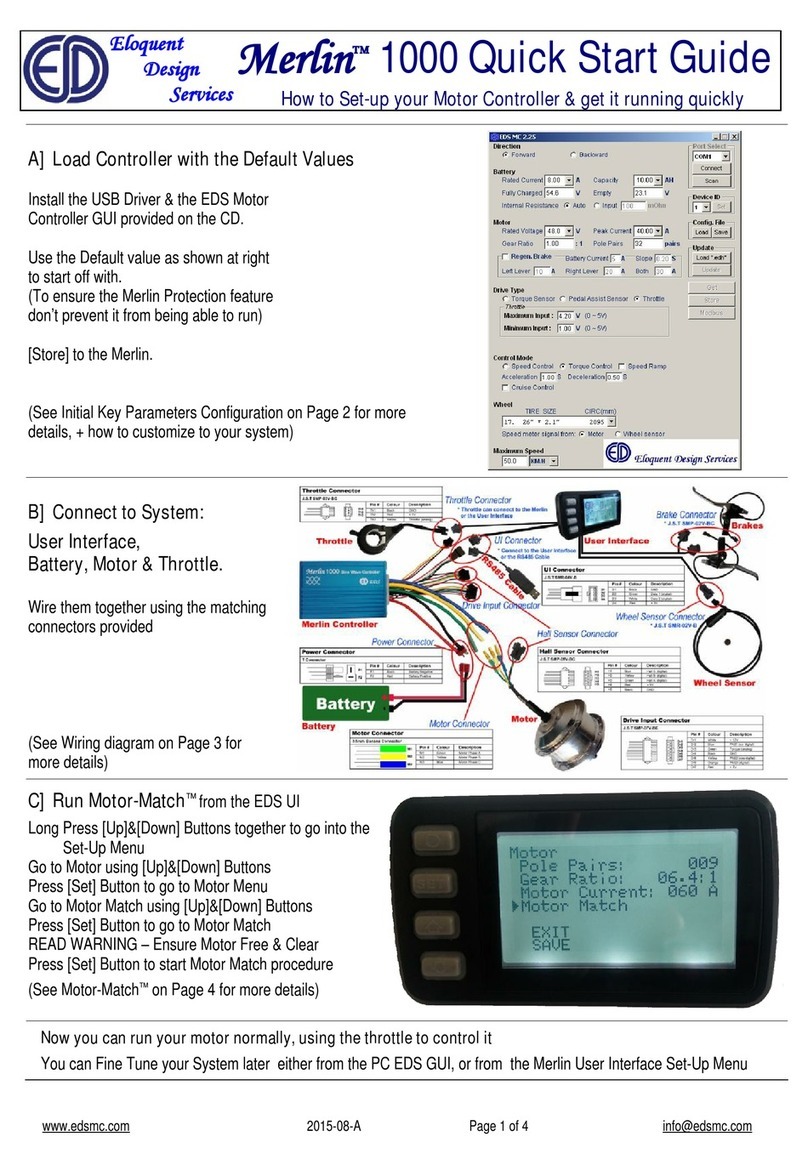
2BL 9228 / 06.12.07 e
Function diagram
t
t1t1
t0t2t3t4t0
t0: start
t4: stillstand detection
t0-t1: test
t1-t2: ramp up time
t3-t4: braking time
L1/L2/L3
T1
43-44
33-34
A1/A2
X1
MMot
n
M5663
13-24
T2/T3
Indication
- If the motor does not stand still within 10 sec during brake function
the monitoring relay 1 will indicate this. The brake function is stopped
latest after 15 sec if there is no standstill detection, and the motor
is separated from the mains.
A restart resets the monitoring relay 1. If this error occurs for the third
time the device changes into the error mode. The red LED will flash
code 9.
- By turning the brake potentiometer during braking the standstill
monitoring is deactivated. In this case the motor brakes always with
the maximum motor braking time of 15 sec.
- The brake current switches off after 0.5 sec standstill detection.
- On power up the mains frequency, phase sequence and presence
of all 3 phases is checked.
- Internal temperature monitoring protects the thyristors. With the
function "motor overtemperature" a bimetall switch or PTCs are
monitored. By switching on or off of the power supply this fault can
be reset after the temperature has dropped.
- Monitoring of phases and phase shift protects the motor or the
system. After removing the fault this error can be reset by switching
the power supply on and off.
- After connecting the power supply or after braking until restart a
check will be done if L1, L2 or L3 of the device are separated
from the mains (to ensure that contactor K1 or relay 3 are not welded).
It is detected if 2 or 3 phases are connected in a wrong way and
checked that the on-button is not welded or bridged.
Monitoring features
Function
Monitoring relay 4 (contact 43-44) optional
This relay is energised when motor standstill is detected. It will be reset
by pushing the on-button. The contact can be used for example to lock
a safety gate. The monitoring relay 4 is de-energised if an error occurs.
Input P1/ P2/ P3to monitor the motor temperature
To monitor overtemperature onnb the motor a bimetallic contact can
be connected to P2/ P3. When overtemperature is detected the power
semiconductors switch off and all relays de-energise.
On P1/ P2up to 6 PTC sensors can be connected. On detection of
overtemperature, short circuit or broken wire (in sensor circuit) the
power semiconductors switch off and all relays de-energise.
The fault is reset by disconnecting the power supply temporarily after
the temperature on the motor is down again.
Indication
green LED: Continous light: - when auxiliary supply connected
Flashing light: - while starting and breaking
Monitoring relay 1
yellow LED: Continous light: - when contact 13-14 switched on
Monitoring relay 2
yellow LED: Continous light: - when contact 13-24 switched on
Monitoring relay 3
yellow LED: Continous light: - when contact 33-34 switched on
Monitoring relay 4 optional
yellow LED: Continous light: - when contact 43-44 switched on
red LED: Flashing light : - Error
1*): - overtemperature on thyristor (internal)
2*): - overtemperature on motor or broken
wire in sensor circuit P1/P2
3*): - short circuit on sensor circuit P1/P2
4*): - phase failure
5*): - incorrect phase sequence, exchange
connections on L1 and L2
6*): - incorrect frequency
7*): - incorrect brake circuit
8*): - incorrect safety monitoring
9*): - braking time 3 x higher than 10 s
10*): - incorrect RAM
11*): - incorrect RUN-input (start switch
welded)
12*): - device not separated from mains
(2 or
3 phases occur before start)
1-12*)= Number of flashing pulses in short sequence
Variation of speed is not possible with this device. Without load a
softstart cannot be achieved. It is recommended that the softstart is
protected by superfast semiconductor fuses rated as per the current
rating of the softstart or motor. However, standard line and motor
protection is acceptable, but for high starting frequencies motor
winding temperature monitoring is recommended. The softstarter
must not be operated with capacitive load e.g. power factor
compensation on the output.
In respect to safety of persons and plant only qualified staff is allowed
to work on this device.
Notes






















